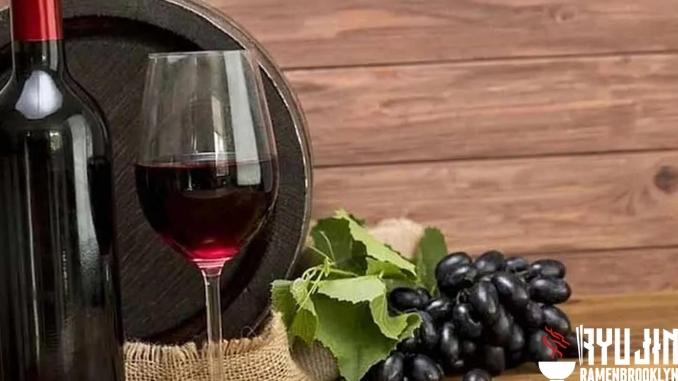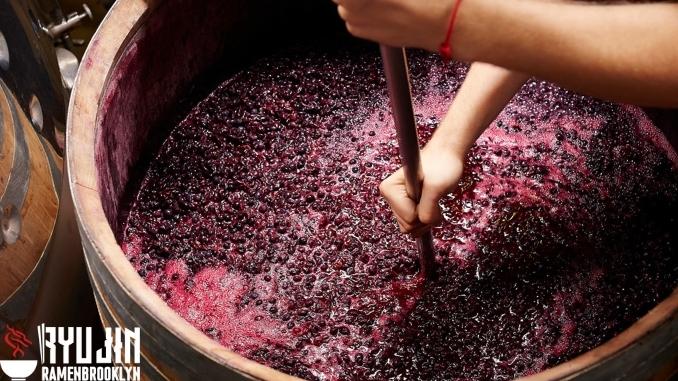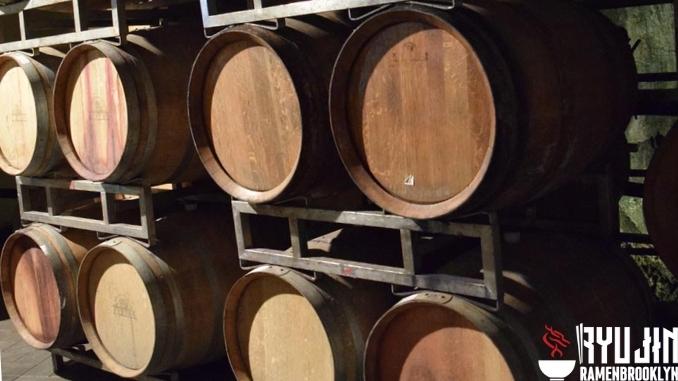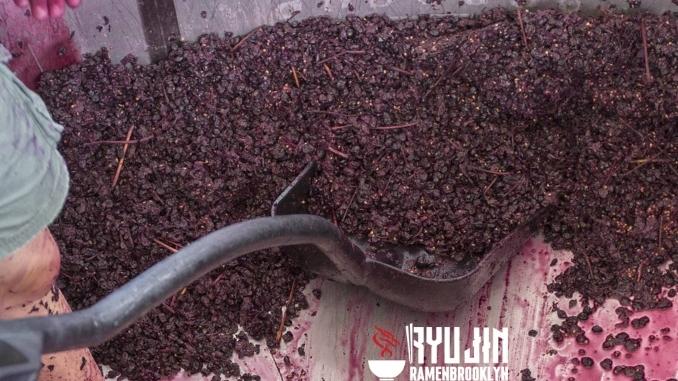How Is Wine Made?
Do you enjoy a nice glass of red or white wine with dinner? Or maybe a cold beer after work? If so, you’re like many other Americans who appreciate the taste and relaxational effects of alcohol. But have you ever stopped to think about “how is wine made?”
Wine is a beautiful beverage that all can enjoy. Making wine starts with picking the perfect grapes for your blend and then deciding how long they will stay on the vine before being turned into something delicious – either sparkling or red! You may have heard some say great wines come from high-quality fruit grown carefully in only select regions across France, but what happens after those picked Standards?
All wine starts with grapes. Grapes are grown in vineyards, and the best grapes are used to make wine. Wine goes through a fermentation process, where yeast is added to the grape juice, and the sugar turns into ethanol. The wine is then aged in oak barrels or cold storage until it is ready to be bottled and sold. There are many different types of wine, and each type has its unique flavor. Wine lovers worldwide enjoy drinking wine for its taste and its health benefits.
Wine production is a complex process that spans many different world regions. There are two general categories for making wines: still (or non-carbonated) and sparkling, with red being one main type but white or rosé also available, depending on taste preferences, etcetera). Although most people think only grapes can be used when processing these alcoholic drinks, other plant sources such as apples may well be found in case you want an apple wine!).
In this blog post, we’ll take a closer look at “how is wine made?“ and discuss some of the steps involved in producing this popular beverage. So sit back, relax, and enjoy learning about wine!
See more: Pairing Wine With Pasta
- How Is Wine Made?
- Winemaking Regions
- Types of Wines and Their Flavors
- Food Pairings With Wine
- How to Store and Serve Wine
- The History of Wine
- FAQs
- How Is Wine Made With Feet?
- How Long Does Wine Last?
- How Many Calories Are In a Glass of Wine?
- Can You Get Drunk Off Non-alcoholic Wine?
- What Is The Difference Between Red and White Wine?
- Can I Make Wine at Home?
- Can Homemade Wine Be Poisonous?
- Is It Worth Making Your Wine?
- How Soon Can You Drink Homemade Wine?
- What Are The Benefits of Making Your Wine?
- Is Sugar Added to Wine?
- Does Wine Have Alcohol?
- What Is The Difference Between Wine and Vinegar?
- Can People With Diabetes Drink Wine?
- How Much Wine Should I Drink?
- What Are The Health Benefits of Drinking Wine?
- Can I Use Frozen Grapes to Make Wine?
- Why Are Some Wines Blended?
- Is Wine Healthier Than Beer?
- Why Do They Put Milk in Wine?
- Can I Drink Expired Wine?
- Why Does Wine Give Me a Headache?
- What Wine Gives You The Least Hangover?
- Do All Wines Have Tannins?
- Can Kids Drink Wine?
- Is Wine Fattening?
- Conclusion
How Is Wine Made?
Wine is a complex beverage that all can enjoy. Making wine is an art that has been perfected over centuries. So, how do you make wine? There are many different ways to make wine, but the basic process remains the same.
Wine is made from grapes, and the type of grape will determine the type of wine made. Red wines are made from red grapes, and white wines are made from white grapes. The best grapes are used to make wine. Wine goes through a fermentation process, where yeast is added to the grape juice, and the sugar turns into ethanol.
Wine goes through a fermentation process, where yeast sites are grown its own unique flavor. Wine lovers worldwide enjoy drinking wine for its taste and its health benefits.
The wine is then aged in oak barrels or cold storage until it is ready to be bottled and sold. There are many different types of wine, and each type has vineyards, and the best grapes are used to make wine.
Harvesting
This is an important stage in the answer to the question “how is wine made?”. The picking of grapes is an important part of making wine. The winemaker has to decide when they should pick, which depends on several factors like acidity and sugar levels detected through tasting throughout the yearlong process.
Teams are then sent out into vineyards with permission from owners/growers who own up to 2 acres each (or 20ha) for this purpose – collecting plenty more fruit than if nobody went!
Grapevines are a lot like people: they have different personalities and preferences. Some vineyards prefer early mornings, while others wait until late into the day to get their pick of fruit from these lush green vines that line up along hillsides or flutter in soft winds across fields – it depends on what kind of mood you’re looking for!
When teams from wineries go out into those same grapes every year during harvesting season (which typically happens between August-October), there is always plenty going through your mind as soon as those picked bunches come crashing down onto tables full blast with juice running everywhere… deciding whether this will be a sweet red typical pinot noir drinkable now or a structured, tannic wine that needs years of age before it’s even worth considering.
A way to gather grapes would involve having workers manually pick them off of individual vines one at a time, which takes forever and yields lower quality fruit due largely because anyone who isn’t doing their job properly ends up getting sorted into different piles anyway, so any preferences or flavors get lost with each pass through the entire process.
Harvesting by hand is the more traditional method, but it can take longer than machine-based harvesting. Many winemakers prefer this way because it’s tough on grapes and vineyards. The ripe or rotten fruit will be removed from their stems, leaving only healthy ones to continue growing into delicious wine!
The vineyards of France produce some world-class wines, but it is not easy work. The grapes are laborers on their own and must be slender enough to handle the rigorous conditions in a year without any assistance from humans or mechanical devices such as harvesters which can cause them damage during the harvesting process; this laborious task requires skillful hands that have been trained since childhood for just such tasks!
After the grapes are picked, they are sorted and destemmed. The sorting process is important because it removes any leaves, stems, or bad grapes from the bunch. De-stemming is also important because it removes the harsh tannins from the grape’s stem.
Crushing/Pressing the Grapes
White wine’s crushing and pressing process is slightly different from red or Rosé producers. First, the grape berries are removed from their stems with a destemmed before being crushed into juice to make them brighter colorless but still full-bodied varieties like chardonnay or Sauvignon Blancs (a light rosé).
For these wines that need extra sweetness due, only Laboratory tests can be done after they’ve been pressed out onto tanks, where they’ll settle over time, then rack off any sediment at this point too!
For red and orange wines to have their color, tannin structure, or “body” they need this time left on the skins. The fruit is crushed (with or without stems) before being left so that it can macerate, which ultimately gives us all those amazing flavors!
When the grapes are finally sorted, they can be destemmed and crushed. For many years people stomped their feet to do this task manually, which is now performed with machines thanks in part to mechanical pressing that has brought about great sanitary gain and increased longevity for wine quality overall!
After the grapes are crushed, they are pressed. This is how the juice is extracted from the grapes. The juice is then put into barrels or tanks for fermentation.
Fermentation
The next stage in “how is wine made” is the fermentation process. This is where yeast is added to the grape juice. The yeast eats the sugar and produces alcohol and carbon dioxide. The carbon dioxide escapes from the tank or barrel, and the alcohol stays in the wine.
Fermentation can be done with either native yeasts or cultivated ones- the difference being that in a spontaneous process, natural yeast on grape skins acts as a starter to start it off while ordering strains from stores will add more spice later if needed! Spontaneous ferments tend to take longer but produce much richer final wines, whereas those executed through hired help often come out faster yet weave closure quickly into their flavors.
Whether it’s an old-world tradition like in France where they use a spontaneous fermentation method that takes much longer than using purchased strains by adding them directly into the juice during the production process; however, if one wants simpler wines, then there exists another option too!
Wines made from red grapes are wines with a “crimson” character. The skins of these fruits spend time in contact, giving them that iconic color and taste before being removed for processing into alcohol; however it’s only during the last few hours where you’ll find some settling on top after immediate removal so there can be at least traces left behind!
With rosé, we do things differently- it’s just enough exposure to start our process without any chemical help like sulfur dioxide or additives such as shape-enhancing chemicals, which give rosés their lighter hue but still maintain ample flavor complexity thanks more to tonal acids found within each seed itself.
The conversion of sugar into alcohol makes winemaking such a natural process. It’s also why you need not leave your fermentation up too long, or else it could end before all the sugary goodness has been turned, economists!
Winemakers will sometimes stop this chemical reaction early by adding enough water. Only about one-third remains conversions are complete, which leaves room for fruits and other flavors, resulting in sweet wines with vibrant colors.
The fermentation process can take weeks or even months, depending on the type of wine made. The fermentation temperature will also play a role in how long it takes for the process to be completed.
Red wine is something that all can enjoy. It’s not just for celebrations or special occasions, but an everyday drink with the whole family! But, how is red wine made? The process of fermentation begins at 70-85 degrees Fahrenheit in large open vessels where it sits until yeast does its job and converts sugar into ethanol – which gives red wines their characteristic flavor profile actors mention “fermenting” when describing what goes on during this time because they’re getting ready to bottle up some deliciousness.
Also, how is white wine made? White wine is the most popular among alcoholic beverages and for a good reason. White wines are less complicated to make than red or rose varieties of table wine; once they’re racked (to separate them from darker colored grapes), clear grape juice becomes fermented at a lower heat–just 45-60 degrees! This process takes several weeks before completion, which allows time during fermentation for bacteria conversion on sugars found in skin cells.
The flavoring and coloring of wine come from contact with the skins of red grapes during fermentation. This is why white wines are usually fermented without skin contact, while red wines go through a process where they macerate (or soak) in their juices for an extended period – sometimes even up to a month!
This is how tannins are introduced into the beverage, which provides that astringent taste and dry feeling in your mouth after swallowing. If you’ve ever wondered how wine gets its color, now you know!
Aging
The type of vessel a winemaker ages their wine in will greatly impact how it tastes. The aging (or élevage) regimen of wine is largely dependent on the type and style desired.
For example, red wines are typically aged in barrels before they are bottled. This helps soften the tannins in the wine and gives it a smooth texture. On the other hand, white wines are usually aged in tanks or stainless steel barrels. This helps to preserve the crisp flavors of the wine.
Several factors must be considered in deciding what kind of vessel to use for aging wine. First is the choice between steel or cement tanks; these may become available depending on whether you have your winery with its storage facilities. If not, this will likely mean purchasing them from another producer who uses both types (and can easily switch back).
One option might also include using other materials such as terra cotta clay glasses – though these come at an increased price point due directly because they’re handmade by artisans rather than factory-manufactured products like most others would be here in America!
Some people prefer the flavor of French oak, while others go for American. The two most popular types are these, and each has its unique qualities depending on where it’s a grown-a subtle spice with vanilla hints from America or full-bodied complexity reminiscent of that found in a good Port facility near Tuscany!
There is no size fits all solutions when it comes down to how you want your favorite beverage handled, so make sure that any decision about what kind goes into production reflects exactly what tastes like; after all, nobody wants something artificial tasting anyway, right?
Oxidative aging is when the wine comes into contact with oxygen. This process tends to develop different levels of texture and flavor in a bottle, as it’s not just fresh fruit that you taste but also tannins from wood extractions along the way!
However – wines can be preserved without exposure if there are no external elements adding anything additional like extra flavors or sweetnesses found on their own through time-based storage methods such as steel tank fermentation.
Then, placement inside ceramic jars made specifically for this purpose at controlled temperatures below 45 degrees Fahrenheit prevents any change whatsoever, so your favorite vintage will always stay delicious no matter how old they get! Aging is an integral step in the winemaking process, and is something that is always mentioned when talking about the question “how is wine made?”
Filtering the Wine
The fine particles in wine give it its color, so removing them is not only desirable but essential to achieve clarity. The best way for winemakers to do this process correctly requires adding an agent that bonds with these unwanted specs and makes them larger – allowing you to see through all of those cloudy days!
Filtering through a porous material like nylon mesh allows for more clarity while removing all solids – this includes both sedimentation (from things settling on top) and color molecules that can sometimes coat onto its surface over time if left unchecked.
However, these are generally harmless due to only cosmetic reasons behind choosing one method instead of another depending upon preference.
Fining requires adding something specific like bentonite clay which will attach to yeast cells and other large particles before dropping them out of suspension.
Wine lovers should make sure they research the ingredients of any vegan wines before drinking them. While there are some options, such as bentonite (clay) or blood orange juice for fining agents, which can be found in many wineries today- most come from animal products like milk and eggs with white proteins combined with gelatine sheets made out of fish guts to name just a few examples!
This is how most reds get their super-clear appearance while still maintaining the wonderful flavors that make them so delicious!
Bottling
Once everything is just how you want it, the final step is to get that wine into a bottle, ready for consumption!
This usually happens via gravity filling, where the container is placed on top of the spout and left to slowly fill up until it reaches the very top before being sealed with a cork (or screw-top).
Corking the bottle is a centuries-old tradition that has been abandoned by many in favor of screw caps. Cork provides an excellent seal, but it can trap dirt and lead to spoilage due to its inability (or unwillingness)to keep out bacteria as metal does; however, some sommeliers argue this isn’t necessary since they’re only serving you one glass!
Faster methods exist but are often reserved for wineries producing large quantities at once since they require additional machinery like pumps, which can speed up production rates significantly.
That’s all you want to know about “how is wine made?”. Afterward, all that’s left is to sit back, relax, and enjoy a nice glass of your handiwork!
Winemaking Regions
Wine made from different grapes grown in various regions will have unique flavors and characteristics.
Some of the most popular wine-growing regions include:
– France
– Italy
– Spain
– Australia
– United States
Wines from these regions will typically have distinct flavors that represent the climate and terrain where the grapes were grown. For example, wines from warm climates tend to be fruitier, while those from cooler climates are often more acidic.
Types of Wines and Their Flavors
There are many different types of wines, each with its unique flavor profile.
Some of the most popular types of wines include:
– Red wine: Red wines are typically made from dark-colored grapes and have flavors that range from fruity to earthy. Common red wine varieties include Cabernet Sauvignon, Merlot, and Pinot Noir.
– White wine: White wines are usually made from lighter-colored grapes and tend to be more acidic than red wines. Popular white wine varieties include Chardonnay, Sauvignon Blanc, and Riesling.
– Rosé wine: Rosé wines are made from a blend of red and white grapes and usually have a light pink color. They tend to be semi-sweet with flavors of berries and other fruit.
– Sparkling wine: Sparkling wines are made by adding carbon dioxide to wine, which gives them their signature fizz. They can be red or white, but Champagne’s most popular type.
Food Pairings With Wine
Wine is a versatile beverage that can be enjoyed on its own or paired with food. To have a complete party, it is essential to learn all about what you are using, not only “what is this wine?”, “how is wine made?”, but you also need to find a way. that they combine with food to create the perfect flavors. When pairing wine with food, there are a few general guidelines to follow.
– Red wines pair well with meats, hearty pasta dishes, and rich cheeses.
– White wines pair well with lighter fare such as salads and seafood.
– Rosé wines are versatile and can pair well with red and white wines.
– Sparkling wines are also versatile and can be enjoyed with various foods.
No matter what you’re eating, there’s a type of wine that will pair well! So, go ahead and experiment to find your perfect match.
See more: What Wine With Lamb?
How to Store and Serve Wine
Proper storage and serving of wine are essential to ensuring that it tastes its best.
Here are a few tips to keep in mind:
– Store wine in a cool, dark place.
– Serve red wine at room temperature and white wine chilled.
– Use proper glassware for each type of wine.
– Decant red wines before serving.
With these tips in mind, you’ll be sure to enjoy your wine at its best!
The History of Wine
The history of wine is a long and fascinating one. Wine has been around for thousands of years and has been enjoyed by people worldwide.
The earliest known mention of wine is in the Bible, which tells the story of Noah planting a vineyard after he survived the great flood.
Wine made its way to ancient Greece and Rome, where it was enjoyed by both the elite and commoners alike.
Wine continued to be popular throughout the Middle Ages and Renaissance, with many famous writers and artists (such as Leonardo da Vinci and Michelangelo) enjoying it regularly.
Today, wine is enjoyed by people worldwide and is produced in countries on every continent.
So, next time you enjoy a glass of wine, take a moment to think about all the history and tradition of making it! To continue with the topic “how is wine made?“, next we will ask some frequently asked questions on the web or exchanged in real life, as well as give their answers.
FAQs
How Is Wine Made With Feet?
The process of making wine with feet is called treading. Treading is when grapes are crushed by foot to release their juice. This method was once the most common way of crushing grapes, but now it is mostly used for high-quality wines.
How Long Does Wine Last?
Wine can last for many years if it is stored properly. Red wine typically has a longer shelf life than white wine. When stored in a cool, dark place, red wine can last 5-10 years, and white wine can last 3-5 years.
How Many Calories Are In a Glass of Wine?
A standard glass of wine (5 oz) has around 120-125 calories. However, this can vary depending on the type and how sweet the wine is.
Can You Get Drunk Off Non-alcoholic Wine?
You cannot get drunk on non-alcoholic wine because it contains no alcohol. Non-alcoholic wine is made by removing the alcohol from regular wine through fermentation.
What Is The Difference Between Red and White Wine?
The main difference between red and white wine is the color of the grape skins. Red wines are made with red or black grapes that have been crushed with their skins. White wines are made with white or green grapes that have been crushed without their skins.
Can I Make Wine at Home?
Yes, you can make wine at home! But, how to make wine at home? To make wine, you will need fermentation equipment and ingredients, and know how to make wine from grapes. You can find everything you need to get started online or at your local homebrew shop. Don’t forget to learn about how to make your own wine to be able to fulfill your purpose in the best way.
Can Homemade Wine Be Poisonous?
No, homemade wine cannot be poisonous. However, if it is not made correctly, it can spoil and develop harmful bacteria. It is important to follow directions carefully when making wine at home to ensure that it is safe to consume. Don’t be fooled when you’re learning how to make homemade wine.
Is It Worth Making Your Wine?
That is a difficult question to answer. It depends on how much you like to drink wine, how much money you want to spend, and how much time you are willing to invest. If you enjoy drinking wine and want to save money, making your wine can be great. If you are short on time or do not like wine, it may not be worth it.
How Soon Can You Drink Homemade Wine?
You can drink homemade wine as soon as it is finished fermenting. However, it will taste better if you wait a few weeks to let it age.
What Are The Benefits of Making Your Wine?
Some of the benefits of making your wine include saving money, customizing the flavor, and having a unique product. Making your wine can also be a fun and rewarding hobby.
Is Sugar Added to Wine?
No, sugar is not added to the wine. Grapes naturally contain sugar, converted into alcohol during the fermentation process. Some wines may taste sweeter than others due to the type of grape or the winemaking process, but sugar is not added to the wine.
Does Wine Have Alcohol?
Yes, wine contains alcohol. Wine is made by fermenting grape juice, which creates alcohol. The alcohol content of wine can range from 0.5% to 14%, depending on the type of wine.
What Is The Difference Between Wine and Vinegar?
Wine is made by fermenting grape juice, while vinegar is made by fermenting alcohol. Vinegar has a stronger flavor than wine and is used for cooking or condiment.
Can People With Diabetes Drink Wine?
Yes, diabetics can drink wine. However, they should be aware that wine contains sugar and calories. They should also monitor their blood sugar levels carefully when drinking wine.
How Much Wine Should I Drink?
There is no definitive answer to this question. It depends on your personal preferences and how much alcohol you are comfortable drinking. It is safe to drink 1-2 glasses of wine per day.
What Are The Health Benefits of Drinking Wine?
Drinking wine in moderation has been linked with many health benefits, including reduced heart disease and stroke risk. Wine also contains antioxidants, which can help protect against cell damage.
Can I Use Frozen Grapes to Make Wine?
Yes, you can use frozen grapes to make wine. Frozen grapes are a great option if you want to make wine quickly. Simply thaw the grapes and then follow the directions for making wine.
Why Are Some Wines Blended?
Some wines are blended to create a more balanced flavor. Blending can also help to improve the quality of the wine.
Is Wine Healthier Than Beer?
There is no definitive answer to this question. Both wine and beer have health benefits and risks. It is important to drink in moderation and choose a beverage you enjoy.
Why Do They Put Milk in Wine?
Milk is sometimes added to wine to create a creamy, smooth flavor. However, milk can also spoil wine, so it is important to use it carefully.
Can I Drink Expired Wine?
Yes, you can drink expired wine. However, it may not taste as good as fresh wine. If you are unsure whether or not the wine has expired, it is best to err on the side of caution and throw it out.
Why Does Wine Give Me a Headache?
Wine can give you a headache because of the sulfites. Sulfites are added to wine to prevent spoilage, but they can also cause headaches in some people. If you are sensitive to sulfites, you may want to avoid drinking wine.
What Wine Gives You The Least Hangover?
There is no definitive answer to this question. It depends on how much alcohol you drink and how sensitive you are to alcohol. In general, lighter wines such as white wine or rosé wine are less likely to cause a hangover.
Do All Wines Have Tannins?
No, not all wines have tannins. Tannins are found in the skin and seeds of grapes, and they can give the wine a bitter taste. White wines and rosé wines generally have fewer tannins than red wines.
Can Kids Drink Wine?
No, kids should not drink wine. Wine contains alcohol, which can be harmful to developing brains. Kids should also avoid drinking wine because of the risk of alcohol poisoning.
Is Wine Fattening?
You may have heard that red wine is good for your heart, but you may also be wondering if it’s true that wine is fattening. After all, isn’t alcohol calorie-dense?
The answer to this question is a bit complicated. First of all, it depends on what type of wine you’re drinking. White wine generally has fewer calories than red wine. And, sparkling wines like champagne tend to be even lower in calories.
Of course, the calorie content of wine also varies depending on the alcohol by volume (ABV). Wine that is 14% ABV has about 120 calories per 5-ounce glass. But, a wine with an ABV of 18% has nearly 160 calories per glass. So, if you’re watching your weight, it’s important to be mindful of the ABV when selecting a wine.
It’s also worth noting that dry wines tend to have fewer calories than sweet wines. This is because dry wines have less sugar. And, as you probably know, sugar is a major contributor to weight gain.
So, if you’re trying to lose weight or maintain your current weight, it’s best to stick with dry wines that are lower in alcohol. But, if you don’t mind indulging in a sweeter wine on occasion, there’s no need to worry about the extra calories.
At the end of the day, it’s important to remember that moderation is key. This is true for both wine and food. If you enjoy wine, there’s no need to feel guilty about it. Just be sure to drink in moderation and focus on choosing dry wines that are lower in alcohol. And, of course, don’t forget to pair your wine with a healthy meal! That’s all we want to share with you about the question “how is wine made?” and all the other related questions we have listed above.
Conclusion
Winemaking starts with picking the grapes, which can be difficult and time-consuming, but once they are harvested, it becomes clear how much work remains ahead: pressing them into wine takes skillful hands to ensure quality control–and even then, there’s no guarantee of success!
However, growers manage through these challenges every year without fail because this industry produces some of humanity’s favorite drinks like wine or sake (among other things).
Making wine takes many pickers and large, expensive machinery to harvest the grapes, which are then pressed into one of the favorite drinks worldwide! After all that hard work in harvesting them from vineyards across France or Italy, winemakers must be very careful about how they press it out for optimal flavor profile (and quality).
Wine production is an arduous process where many things can go wrong. While quality winemakers invest much time in these processes, mass-produced wines are often created by shortcuts such as including additives and artificial sweeteners to increase alcohol content or speed up the fermentation process for a faster turnaround time.
However, this affects flavor, too, which means you should look out for smaller independent winemakers who make multifaceted, delicious beverages with natural grape flavors at their forefront rather than relying on chemical interventions like sulfites (an SO2 gas)to preserve them because if there’s anything we’ve learned from recent scandals, it’s that our taste buds aren’t always reliable!
That’s all for our introduction to how to make wine! We hope this article has answered your question: “How is wine made?” If you have any questions that we haven’t answered here or would like more information, please don’t hesitate to contact us. You can also check our website for more interesting articles about wine production. Thanks for reading!
Anthony Michelin (March 26, 1960) is the CEO of Ryujinramenbrooklyn.com – is an expert in finding specialized equipment to assist in the Bar & Kitchen sector. With over 40 years of focus on finding the simplest recipes on the most suitable cookware to create the most delicious meals, I believe it will help you.






5 thoughts on “How Is Wine Made? The Process To Make a Good Bottle of Wine”